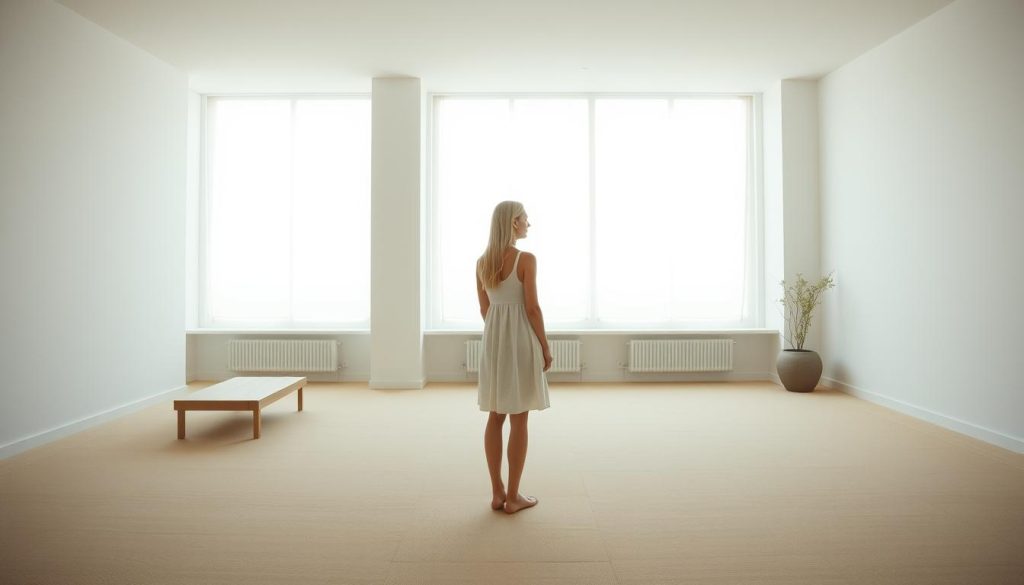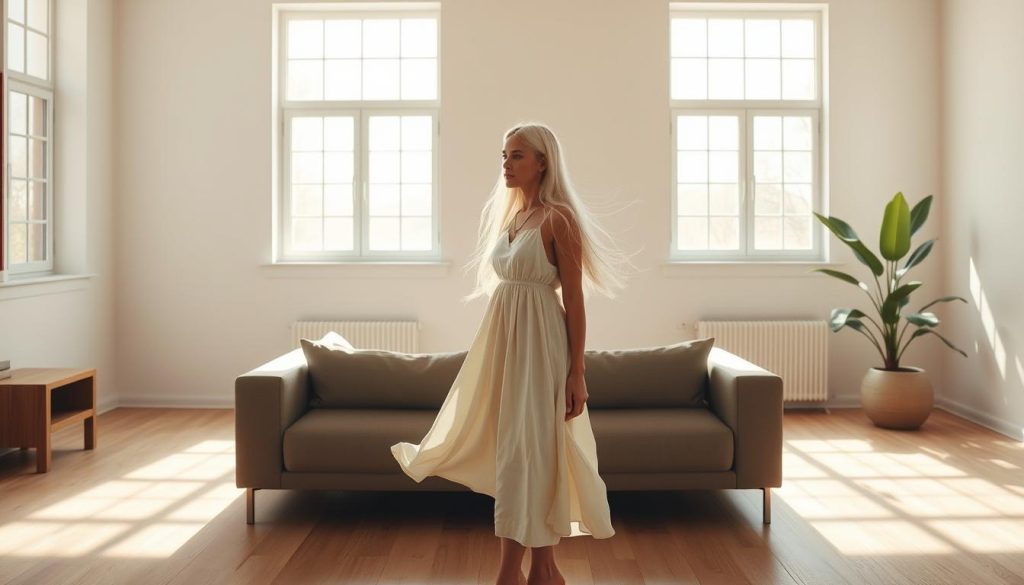Have you ever wondered how less can feel like so much more? I’m glad you asked!
Minimalism is a style defined by extreme spareness and simplicity. It shows up in music, literature, design, and daily choices.
Pronounced ˈmi-nə-mə-ˌli-zəm, the term dates back to 1927 and rose to prominence in the 1960s. Think of pulsing beats and repeated chords by Philip Glass, Steve Reich, and John Adams!
In visual work, artists like Donald Judd and Bruce Nauman used plain shapes and raw materials to make a strong, clear impact. Writers such as Samuel Beckett and Raymond Carver trimmed prose to the bone.
Here’s the payoff: spot this approach and you can name it, explain the core idea, and spot quick examples in galleries, playlists, books, or rooms today!
Key Takeaways
- You’ll get a crisp, usable definition you can apply right away.
- The term emphasizes extreme spareness across fields.
- 1960s creators made the style famous in music and art.
- Real examples help you recognize the approach fast.
- By the end, you’ll explain the concept in one clean sentence!
Defining Minimalism at a Glance
Start with this simple definition and you’ll spot the idea everywhere you look! I’ll keep it short, clear, and useful so you can use it right away.
A concise glossary-style definition
Minimalism is a style or technique marked by extreme spareness and simplicity. The goal is clear: remove excess so the essential stands out.
Pronunciation and the essence
Say it aloud: ˈmi-nə-mə-ˌli-zəm. Short and direct—just like the idea itself!
- Clean definition: a style driven by extreme spareness and simplicity, full stop!
- Form as message: less decoration, more direct impact—the form you see is the point.
- Across disciplines: in music, writing, and art, this approach trims away extras so only essentials remain.
- Quick test: ask, “What’s absolutely necessary here?” That’s the guiding question.
Keep this pocket definition handy—you’ll use it when you judge a work, a space, or even your schedule! Let’s build a solid base so the rest of the guide lands with power.
Minimalism Meaning
At its heart, the concept champions what truly matters and drops everything extra! I want you to spot that instinct quickly.
Think of it as a practical rule: keep essentials, remove noise. That clarity helps you focus on form, function, and purpose.
In visual contexts the term can also point to minimal art, where simple shapes and raw materials do the talking. Yet the broader style applies to music, literature, and design too.
Listen for words like simplicity, restraint, and deliberate limits when people describe the idea. Those signals tell you the speaker values economy and clarity.
- Practical payoff: less distraction, more impact!
- Across fields: the same rule flexes but keeps the goal—clarity.
- Your move: name what’s essential, then cut the rest.
You’re building a sharp eye and precise language. Keep going—you’re doing great!
Origins and Timeline: From 1927 to the 1960s
The word first appears in dictionaries in 1927, but its rise as an artistic force came decades later! I’ll walk you through the timeline so you can spot when things shifted and why it mattered.
First known use and early linguistic use
The earliest recorded use traces to 1927. That gave the term a place in language long before galleries felt its push.
Language prepared the ground. Artists and critics found a word they could rally around as ideas evolved.
The late 1950s–1970s: movements take shape
After the late 1950s, the scene changed fast. Visual art and music moved toward spare forms and steady systems.
Key figures reshaped the field: Frank Stella, Carl Andre, Dan Flavin, Donald Judd, Sol LeWitt, Agnes Martin, and Robert Morris. Composers like Philip Glass, Steve Reich, and John Adams did the same in sound.
- Why it mattered: the shift pushed back at the art world’s focus on precious objects.
- Big picture: the 1960s marked a cultural pivot, and minimalist art became a clear, influential current.
By the end of this period, the style had become a recognized movement that changed how we see form, materials, and systems in galleries and beyond!
Minimalism in Art: Movement, Materials, and Geometric Forms
A bold shift in the 1960s made form and materials the subject, not a window onto something else. The work became its own reality. You meet the piece directly and that meeting is the point!
What you see is what you see, Frank Stella said. That line sums up the core: no imitation of the outside world. The medium and the form speak for themselves.
- Shapes and structure: simple geometric forms—squares and rectangles—dominate the scene.
- Materials: metal, plywood, magnesium, and fluorescent light are chosen for honesty and impact.
- Qualities: truth, order, simplicity, and harmony create calm, powerful work.
Key figures made this language fluent. Look for Stella’s Black Paintings (1959), Judd’s Untitled (1972), Andre’s 144 Magnesium Square (1969), and Flavin’s Homages to Tatlin. Sol LeWitt, Agnes Martin, and Robert Morris also clarified the code.
“What you see is what you see!”
After a quick look you’ll spot minimalist art fast. The choices are clear: form first, materials honest, and composition built around geometric clarity. That’s the power of the movement!
How Minimalist Art Differs from Representation
Minimalist works refuse to be windows onto other stories; they stand plainly as objects in front of you. You meet shapes, materials, and scale without a hidden script.
“What you see is what you see” explained
“What you see is what you see!”
This line means the piece is its own subject. It does not point to an outside scene or private emotion. The focus is direct presence.
Stripping personal elements vs. expressive traditions
Artists dropped personal gestures and dramatic cues. Instead they arranged geometric forms and honest materials. The result is clear and shared.
In contrast, expressive traditions use symbolism, stories, or biography. Those works invite decoding. Minimalist practice asks you to stay with the object now.
| Feature | Minimalist Approach | Representational Approach |
|---|---|---|
| Intent | Present the object | Refer to a scene or emotion |
| Visual elements | Geometric forms, material clarity | Figuration, symbolic detail |
| Viewer task | See and feel the work itself | Interpret story or meaning |
You’ll leave with a sharper eye! Focus on what sits before you and notice how light, scale, and repetition shape the experience.
Minimalism in Music: Repetition, Pulse, and Subtle Change
You can hear the style instantly: steady pulses and repeating cells that slowly shift over time. This music makes pattern and time the main attraction!
Roots and reach: In the 1960s composers drew on rhythms and structures from India and Southeast Asia. That global influence shaped pulsing beats and repeated chords.
Key composers and approaches
Philip Glass, Steve Reich, and John Adams are prime examples. Each uses repetition differently: Glass layers chords, Reich explores phase and pulse, Adams blends minimalist cells with orchestral drama.
How to listen: a quick exercise
Pick a short motif. Track it for five minutes. Notice tiny changes—a shift in harmony, an added beat. Those micro-shifts reshape your whole perception!
- You’ll tune your ear to steady pulse and repeating patterns!
- Repetition acts like a living engine—moment to moment, the music evolves.
- This approach links music to visual art through restraint and gradual change.
| Feature | Musical Role | Listening Cue |
|---|---|---|
| Pulse | Drives forward motion | Feel the steady beat |
| Repetition | Builds texture | Notice recurring motifs |
| Gradual change | Creates tension and release | Track small edits over time |
Minimalism in Literature: Style, Form, and Restraint
In fiction, the power often lives in what the writer leaves out. You read between the lines and your mind completes the scene!
Concise prose and pared-down narrative
Good minimalist prose uses short, clean sentences. Each line earns its place. That makes the text feel urgent and true.
Sparse description invites the reader to participate. Details are chosen with care. Omission becomes a tool, not a flaw.
Notable figures and examples of minimalist fiction
Think of Samuel Beckett and Raymond Carver. Their work shows how restraint is a deliberate style, not a limitation. You learn to trust silence on the page.
“Less can demand more from the reader.”
- You’ll feel how clean sentences and lean scenes land—sharp and clear!
- Precise details can carry an emotional arc without extra words.
- This literary approach mirrors visual art: fewer moves, stronger impact—just like minimalist art.
- Try it: cut three lines from a draft and see how the meaning tightens!
Result: you read more actively, and your own writing gains focus and energy. Say less, mean more, and watch the effect!
Design and Everyday Style: Simplicity in Shapes, Use, and Materials
Good design clears the clutter so daily life runs smoother and feels calmer. I want you to bring that clarity into your space and your stuff!
Forms and function in product and interior design
Forms follow function: choose pieces with clear purpose. A chair should sit well. A table should hold what you need. When each object has a job, extras fade away.
Plug-and-play interaction matters. Think intuitive controls, readable labels, and furniture that fits the moment. That saves time and lowers friction in daily routines.
Visual style: clarity, universal interfaces, and elegance
Favor clean shapes and honest materials. Wood, steel, and glass age well and read as straightforward. The look feels calm and capable.
Universal interfaces make choices easier. Simple icons, clear buttons, and streamlined flows cut decision fatigue. You’ll notice energy return when the small stuff stops nagging.
- You’ll bring calm home with clean shapes and honest materials!
- Design with purpose: every element serves clear use.
- Universal interfaces simplify choices and speed routines.
| Aspect | Design Goal | Everyday Result |
|---|---|---|
| Shapes | Clear, geometric forms | Easy visual calm and quick recognition |
| Materials | Durable, honest finishes | Less upkeep, lasting appeal |
| Use | Essential features only | Fewer decisions, more focus |
| Interfaces | Intuitive controls | Fast, stress-free interactions |
Influences and Related Movements
The story of this style is a chain of influences that links factories, avant-garde theory, and gallery practice! I want you to see the line from early modern experiments to the 1960s art world.

Links to conceptual art in the 1960s–1970s
In the 1960s and 1970s, conceptual artists shifted focus from object to idea. Systems, instructions, and viewer experience mattered as much as the physical work. That move helped shape how you encounter art today.
Roots in Russian constructivism and suprematism
Earlier, Russian constructivists and suprematists cut forms to essentials. They prized structure over ornament and favored geometric clarity. Those experiments taught later artists to think in pure elements.
Factory techniques, essential structures, and modular forms
Factory methods and modular parts made work precise and repeatable. Think of simple modules stacked or repeated. That approach shows up in how artists chose materials, scale, and rhythm.
- Key links: Flavin’s Homages to Tatlin (begun 1964) salute Tatlin’s spirit.
- Connections: Robert Morris cited Tatlin and Rodchenko; Donald Judd wrote on Malevich’s legacy.
- Your takeaway: these lineages explain why clarity and systems often beat illusion in modern practice!
Common Concepts and Terms in Minimalism
Let’s untangle the labels so you can name what you see with confidence! I’ll keep this short and useful.
Labels: names that matter
Minimalist art usually points to the 1960s–1970s visual movement. Minimal art is a related label critics used. And minimalism covers art, music, literature, and design as a broader concept.
Core terms across fields
Forms and shapes do the heavy lifting! A single geometric form can set rhythm, scale, and focus.
Materials matter too: metal, wood, light, and text are chosen for honesty and impact.
Use shifts by field: function in design, perception in art, process in music, and implication in writing.
- You’ll learn vocabulary fast and speak about works with confidence!
- Modularity appears often—series, units, and repeatable systems create order.
| Term | What it points to | Why it matters |
|---|---|---|
| Minimalist art | 1960s–70s movement | Sets visual rules: geometry, scale, material honesty |
| Forms / Shapes | Visual building blocks | Create rhythm and focus without decoration |
| Use / Function | Field-specific | Design: utility; Art: presence; Music: process |
“Learn the terms and the work will speak clearer to you.”
Examples and Current Usage in the Wild
You spot the trend in headlines, runways, playlists, and product pages—it’s everywhere! I want you to see how the word travels across fields and what that looks like in real life.
How media use the term today
Fashion outlets like Vogue praise clean silhouettes and “no-makeup minimalism” as a fresh, wearable example of the idea.
Music coverage—from Pitchfork to NPR—labels certain tracks “electronic minimalism” when patterns, pulse, and space drive the mood!
Tech, lifestyle, and press
Forbes and Slate applaud gadget design that favors plug-and-play interaction and universal interfaces. Clear controls feel humane and elegant.
Lifestyle pieces in CNN and The Seattle Times show flexible living and travel-ready setups as practical examples people try at home.
“Try a quick audit: pick one space, one playlist, one outfit—simplify each and notice the compound calm!”
- You’ll see examples in fashion, music, tech, and home life.
- Design wins when fewer steps and clear labels reduce friction.
- Media use spans the world of outlets—same signal, new contexts!
Try it now: pick one object and strip it to its use. You’ll notice how small edits add up to big calm!
Misconceptions: One Concept or Many?
It’s tempting to treat the whole idea as a single rule, yet each practice plays by its own logic! I’ll help you see why the shared label can hide useful differences.

Why art, music, literature, and design aren’t identical
In visual art, artists pushed against representation. The work stands as an object, plain and present.
Music often uses tight repetition and slow shifts to shape time. That’s a different toolset and aim.
Writers focus on omission and concise lines. The page asks readers to fill gaps with feeling and thought.
Design puts function first. Clarity, use, and intuitive controls drive choices more than pure form.
Where meanings overlap—and where they don’t
Restraint, reduction, and focus unite these fields. Those family traits matter and explain why critics group the movements together.
Yet outcomes differ. What gets removed, and why, varies by medium and audience. Ask: What’s being reduced? To what end? For whom?
- You’ll clear up a big myth: there is no single, monolithic concept that fits every field!
- Family traits: shared restraint, but distinct goals in each practice.
- Smart view: spot the overlap and respect the differences—your reading gets sharper!
| Field | Core Aim | Primary Tactic |
|---|---|---|
| Art | Presence and objecthood | Anti-representation; material honesty |
| Music | Perception of time | Repetition, pulse, gradual change |
| Literature | Reader engagement | Concision, omission, spare prose |
| Design | User clarity and function | Essential features, clean interfaces |
Conclusion
Conclusion
You can now spot essential form, pulse, and sentence with ease! You’ve learned how truth, order, simplicity, and harmony shaped a movement in the 1960s and how it still appears across the world.
Keep simplicity at the center! Less noise gives more clarity. In art and beyond, look for honest materials and intent-driven choices.
One simple action: remove one nonessential thing today and enjoy the energy it frees up! When in doubt, ask: what’s essential here? Let that guide you.
You did it—you’ve built a practical mindset. Stay focused, calm, and creative—make it count every day!
Discover the transformative power of authentic healing crystals from Conscious Items, designed to align your spirit and connect you with nature’s energy. With over 500,000 satisfied customers and a 4.9/5 Trust pilot rating, don’t miss out on finding your perfect crystal—shop now before these unique treasures are gone! Take their exclusive crystal quiz today at Conscious Items to uncover your spiritual muse.
If you liked reading this article you will love this article Crystal Healing Properties: Unlock White Crystal Power!
Elevate your spiritual journey with Conscious Items’ genuine gemstones, trusted by thousands and backed by a 30-day money-back guarantee. Don’t let these powerful crystals pass you by—stocks are limited, and the perfect one for you is waiting! Visit Conscious Items now to find your crystal match before it’s too late.
If you liked reading this article you will love this article Minimalism Checklist: The ONLY Checklist you need
Morganite Crystal Healing Properties
Habits of Healthy Relationships: 10 Keys to Lasting Love: The Ultimate Love Stone for Heart Healing




